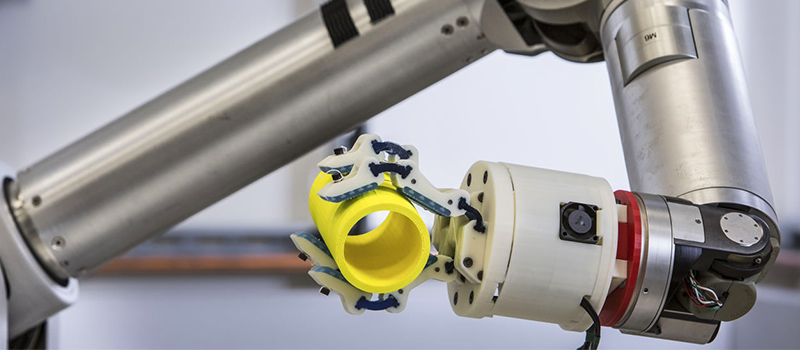Yale University brings us quite a treat with their Openhand Project.
If you’ve ever operated a robotic arm, you know that one of the most cumbersome parts is always the end effector. It will quickly make you realize what an amazing work of engineering the human hand really is, and what a poor intimation a simple open-close gripper ends up being.
[Yale] is working to bring tendon-driven robotic hands to the masses with an interesting technique of combining 3D printing and resin/urethane casting. Known as Hybrid Deposition Manufacturing (HDM), it allows the team to 3D print robotic fingers that also contain the mold for finger pads and joints, all built right into the 3D part. The tendon-driven fingers allow for a very simple design that are not only easy to make, but have a low parts count as well. Because of the human-like tendons, the fingers naturally curl around the object, distributing it’s force much more evenly and naturally, much like a human hand would. In the videos after the break, you can see the building process, as well as the hand in action.
Best news is that it’s all open source. They also include some python libraries so you can customize the CAD files fit your needs.

















Or get a 3d printer with dual or triple nozzle and use and inteliget slicer to 3d print the fingers with a low fill density rubber portions and ABS/PLA hard structures….. Less work in my eyes.
Still a clever technique for combining materials.
Its got to have many more applications.
and the open source nature of the hand designs has to be applauded.
OPEN SOURCE FOR THE WIN!
Intimation? Shouldn’t that read imitation?
Well … hands only is poor intimation …
Ya, but it’s intimation with one that you love.
Yes, but has it mastered the pinch and roll?
Oh wow. Being a new 3D printer owner (Albeit just a Chinese knockoff MakerBot replicator) who loves robotics… I have _got_ to make me one of these and an arm to put it on… It’d definitely be an upgrade from the RadioShack Armatron I had when I was a kid. ;)
I wonder though, why didn’t they print the the rubber parts in NinjaFlex and/or Taulman PCTPE? Could’ve just gone dual extruder and done the whole thing in one pass, no need for the break-away bits either, that way. Though, the whole “3D printed part with built-in molds” thing is inspired and really slick.